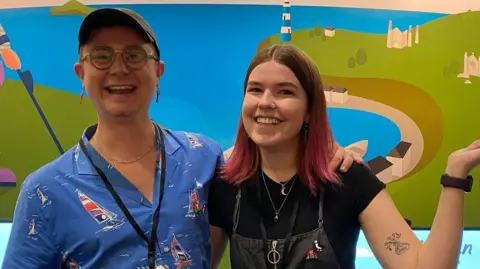 Studio Morgan
Studio MorganWhen Holly Hudson enrolled on a university video game design course, she imagined a job at a studio would be waiting at the end of it.
Her dream was to work as a 3D artist, but the reality has been different.
“I’ve applied to so many jobs this year,” says the 25-year-old.
“But it’s just, it’s really tough.”
Holly graduated in 2023, just as a wave of layoffs and studio closures began to sweep across the industry she hoped to enter.
It’s a trend that’s continued and, in 2025, the picture is still fairly bleak for those looking for jobs in gaming.
According to industry body UKIE, as of June this year, there were just under 700 active vacancies in UK game development.
Fewer than 5% of those were in junior positions, it said.
But Holly and others like her are finding ways to follow their passions and get their creations out there.
Despite struggling to find a full-time job in the industry, Holly has just released her first commercial game alongside uni course mate Harvey Hayman.
Morgan: Metal Detective – a “cosy” slow-paced adventure game set in Cornwall -began life as their end-of-year project.
Players take on the role of Morgan, a young girl who uses her late grandfather’s metal detector to find lost items and return them to residents on a small island.
Holly and Harvey tell BBC Newsbeat it’s a personal project for both of them, inspired by childhood holidays in south-west England, but one they’ve had to work hard to get over the line.
Funding for new video games has also declined in the past two years, so the project has been largely self-financed.
“It’s basically Holly and I trying to pick up contracting work where we can,” says Harvey, who also has a job at a TV production company.
“And so it’s like having to balance these different things,” he says.
“We really want to release this game, but also we need some money to live on and make sandwiches.”
 Studio Morgan
Studio MorganThe most recent figures from the UK Parliament show that 4,800 students began video game-related degrees in 2021.
Holly believes that the route she and Harvey have taken is “quite common” among their peers.
“There’s a couple of us that have gone on to start our own studios,” she says.
Other young people are finding success via Roblox and Fortnite – using in-game tools to create levels and experiences to share with others.
For those willing to put the hours in, it can be lucrative.
Sonny Tranter, 23, started making maps in Minecraft before moving over to Fortnite, where his creations caught on and found an audience.
This led to partnerships with well-known brands, and Sonny, better known as Driz, has recently set up his own studio dedicated to building Fortnite content.
Epic Games, which makes the multiplayer hit, says 40% of net revenue from the game’s item shop is shared among creators according to the level of engagement they generate.
If an “island” – as the creations are known – attracts new players, brings back lapsed fans or gets regular return visits, it will generate more money for its makers.
Sonny says Fortnite uses an algorithm based on these metrics, similar to YouTube, to decide which ones to promote to users.
He admits that can make it difficult for newcomers to make a mark and push more unique creations.
“If you want to make a game that’s different, but still does well, I think the best strategy is probably build off what’s already popular and make it unique in your own way,” he says.
 Driz
DrizDevelopers like Holly and Harvey face a similar problem of visibility.
With thousands of new games released each year – getting yours seen is another huge challenge for independents.
“We’ve tried as hard as we can without spending a lot of money,” says Harvey.
“Because there’s one way to guarantee game sales – have a load of cash so you can just put marketing on the side of buses.
“But we don’t have that.”
Harvey says he and Holly have taken opportunities to showcase the game whenever they’ve arisen – even being flown out the USA.
He says each appearance usually leads to a bump in wishlists – where potential players can register their interest on online stores – which have “built up slowly over time”.
UKIE, which represents the games industry, says there are “more routes than ever” into gaming careers but access to entry level jobs remains “challenging”.
“We’re seeing the tools and knowledge needed to build a game become more accessible every year, which is helping to democratise entry into the industry,” a spokesperson said.
They said UKIE was in discussions with the government about ways apprenticeships and similar programmes can “provide pathways for new entrants and help upskill the current workforce”.
Scott Alsworth, from the IWGB Union’s game workers’ branch, said the UK games industry faced “apocalyptic conditions” after years of mass layoffs, overspending “and AI-driven displacement”.
He said workers at all levels of also struggled to find stable employment in the current climate, on top of the outlook for graduates or new entrants.
“Aspiring working-class developers have it particularly bad,” he said, adding that the UK’s gaming workforce lagged behind industries such as film and TV in terms of representation.
Despite this, both Holly and Harvey wouldn’t discourage those with a passion for games from following it.
Holly says the games industry is “so friendly” and supportive and meeting others in the same situation has made the past two years “more manageable” for her.
She expects more young developers to launch their own studios in the coming years.
“It’s quite an interesting path to take rather than just being rejected over and over again,” she says.
“But I think hopefully it’s quite inspiring and it shows people that actually there are different ways to make games rather than getting a publisher and finding money that way.”


